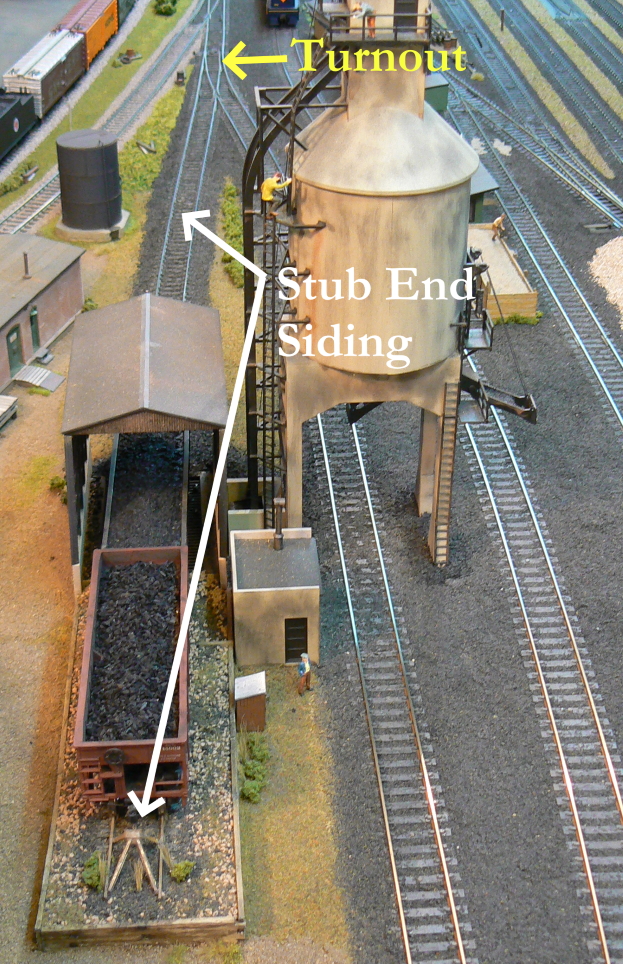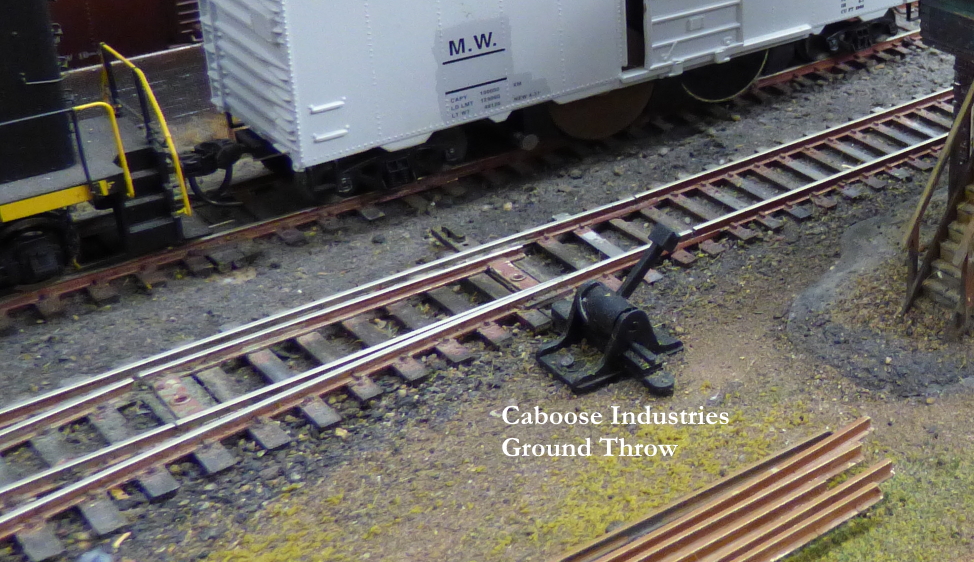Good track is one of the most important things to get right in model railroading. Few other things will have such a great impact on your enjoyment of this great hobby.
The good news is that good track is achievable, with a little bit of knowledge and a little bit of patience.
What type of metal is best for the rail?
Nickel silver.
Next topic.
No, seriously, the only choice is nickel silver.
In the past, brass rails were common, especially in toy train set track. Steel was also used. Both of these metals had problems with their oxide poorly conducting electricity to the locomotive wheels; this required frequent cleaning of the rails to provide reliable operation. Also, brass has an unrealistic yellowish color that is quite unlike the shiny silver appearance of rails on the “prototype” (i.e., on the full-sized railroads that we recreate in miniature).
Nickel silver, on the other hand, has an oxide which is a better conductor of electricity. Also, its silver color is much closer to the shiny appearance of the head of the rail on well-used prototype track. Although the shiny appearance looks fine on the rail heads, it does not look prototypical on the sides of the rails. This can be remedied with some weathering (See
Part 10 of this Guide and the link to a helpful video at the end of this page.)
What type of track should I use?
There are four main types of track:
As a beginner, you should only consider the first three. Hand-laid track can be beautiful, but you should build at least one or two “beginner layouts” before tackling it.
Sectional Track
This is what was included with every train set until about twenty years ago: Fixed lengths of straight and curved track, with black plastic ties and rails, firmly held in them. The ties at the ends of each section have huge, unsightly U-shaped gaps to allow room for rail joiners.
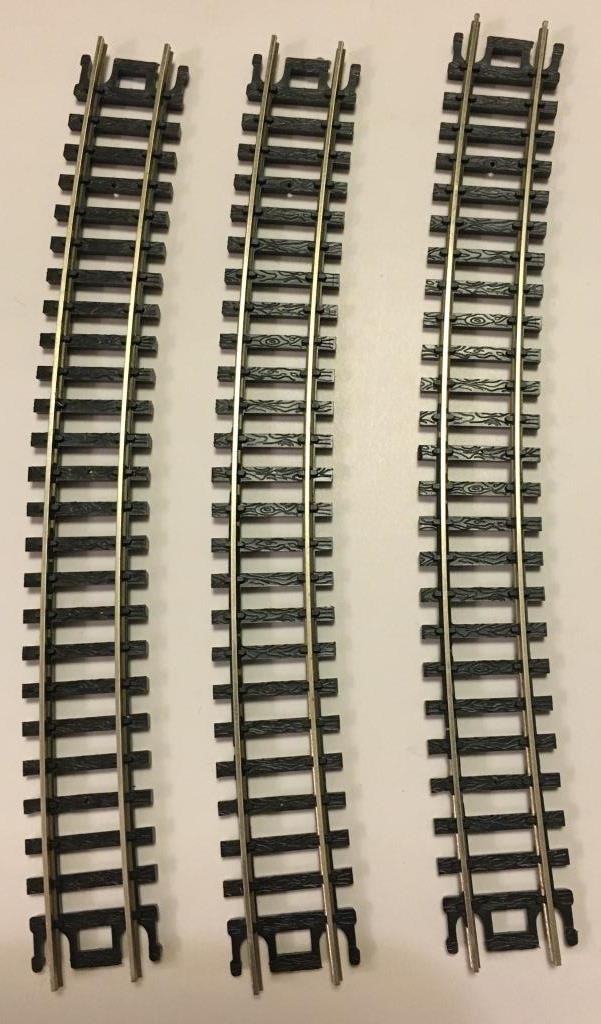 Sectional track
Sectional track
To fit special track arrangements, various lengths of straight track are available as well as different radii and lengths of curved track. Track turnouts (switches) are available too, but virtually always with the diverging route continuously curving, and using the smallest radius offered. The idea is that the turnout – possibly with a short-curved track section included in the switch’s package – can be a drop-in replacement for one standard section of curved track. By contrast, prototype track switches stop curving before the frog (the casting where the opposite-side rails cross each other), and the diverging route is straight through and beyond the frog.
Sectional track is great if you’re following a published track plan (e.g., in a book by Atlas, or by Kalmbach, the publishers of Model Railroader magazine). They’ve carefully figured out which track pieces to use in which arrangement to get smooth joints throughout the whole layout.
If you try to design your own plan using sectional track, be very careful: If you have a closed loop of track more complex than a simple oval, and/or sidings that are connected to another parallel track at both ends, you may need to make expert geometric calculations to avoid having kinks at track joints, where the fixed geometry of the sectional track just won’t fit your plan. Some track-planning computer programs will let you design a layout with sectional track, and automatically check for smooth connections.
When it’s time to assemble the track sections, take care with the joints: Make sure that both rails slide into, not on top of, each rail joiner. Also, the rail should fit snugly into its rail joiner. A loose connection may let the rails work their way out of alignment, possibly leading to derailments. It can also prevent electricity from flowing reliably from one track section to the next, leading to locomotives stalling from lack of power. If in doubt, throw out the old joiners and use new rail joiners. (Hint: They’re cheap!) Finally, make sure that the flow of the track is smooth, without kinks at the rail joints that can derail trains later on.
Sectional Track with Integrated Roadbed
Over the last twenty years, sectional track with the ties implanted in molded plastic roadbed has replaced “conventional” sectional track in most train sets.
Sectional track with integrated roadbed looks more realistic and connects adjacent track sections more securely, minimizing misalignment and poor electric continuity. Another reason for adding integrated roadbed may be that many people often set up and run their train sets on the floor. Conventional sectional track provides no protection for the locomotive’s sensitive motor and gears against the dirt, hair, carpet fibers, etc. found on the floor in even the cleanest home. Integrated roadbed gives better assurance that the locomotive will have a low-fiber diet.
One complication with integrated roadbed: Tracks from different manufacturers are not likely to connect to each other, even if their conventional sectional track worked just fine together. They often use proprietary mechanical connectors in the roadbed, such as the grey plastic “hooks” in the Bachmann E-Z Track pictured here.
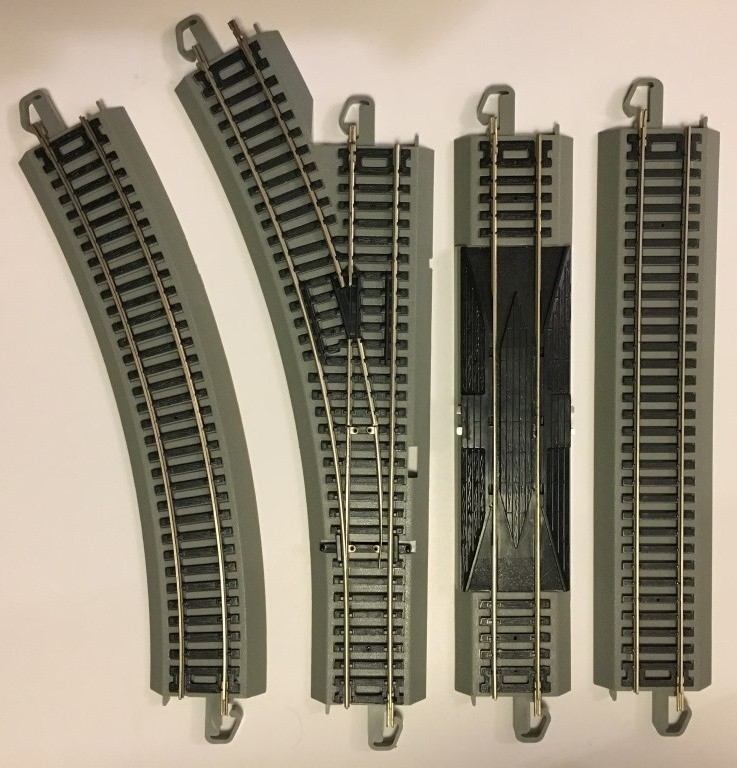 Sectional track with integrated roadbed. Notice that the diverging route keeps curving beyond the frog (the black plastic casting where the opposite-side rails cross); this is typical of sectional track with or without integrated roadbed.
Sectional track with integrated roadbed. Notice that the diverging route keeps curving beyond the frog (the black plastic casting where the opposite-side rails cross); this is typical of sectional track with or without integrated roadbed.
Another complication: With both a plastic connector in the roadbed and the metal rail joiner, you have to be much more careful to ensure that the rail is always firmly held in the rail joiner. It is all too easy to have an end of a rail ride up on top of the adjacent rail joiner.
Flex Track
Flex track, as its name implies, is track that is flexible.
Flex track typically comes in lengths of about two to four feet, depending on scale, with three-foot (or 1 meter) sections being common in HO. There are two main types: Track with gaps between the ties only under one rail (with that rail held loosely so it can slide back and forth), and track with gaps alternating under one rail, then the other, and so on.
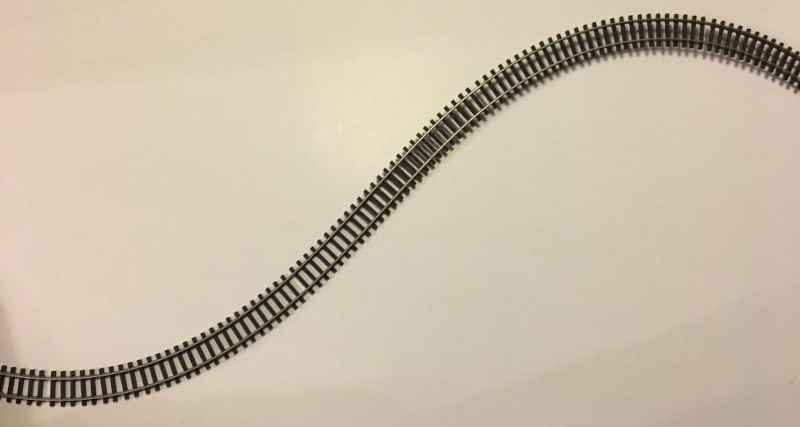 Flex track
Flex track
The photos below show both types of track, flipped upside-down to show the tie strips. Track with the gaps alternating under both rails has been described as “three-foot straight track sections”. It can be bent, by carefully working the ties around with both hands, from one end of the track along to the other end. But it takes skill and patience to get the curve(s) you want and to keep the ties parallel to each other rather than skewing at an angle this way and that. The type on the left is much more flexible and easier to use for beginners.
 All gaps under one rail
All gaps under one rail
 Alternating gaps
Alternating gaps
Why bother with flex track instead of sectional? Flex track has several advantages over sectional track:
-
You can create almost any radius you want, and start and stop curves anywhere. Avoid the temptation, though, to twist flex track into curves that are sharper than the minimum radius you chose when you planned your layout.
-
You can use “easements” into and out of curves, just like the prototype railroads do. Instead of changing immediately from straight track to the curve’s radius, the curve starts almost imperceptibly, and gradually tightens to the final radius. Think of it like gradually turning your steering wheel when the highway curves, rather than keeping the steering wheel straight then suddenly snapping it to the curve. On a model railroad, easements don’t just look more realistic: They help reduce the misalignment between body-mounted couplers on longer cars. And, with flex track, easements are easy! Search the web for “model railroad track easement” for good explanations of how to lay out an easement.
-
Longer sections of track lead to fewer rail joints, with fewer chances for mechanical or electrical problems.
Here are some pointers for using flex track:
-
You will have to cut rail. Get a good pair of flush-cutters (e.g. Xuron “Track Cutter”), and NEVER use them to cut anything harder than nickel silver rail.

-
Flush-cutters will make a clean cut across the rail while mangling the excess part you’re cutting off. But you don’t care about that excess part anyway! If the excess part is long enough to use elsewhere, turn the cutters around and make a new cut leaving a clean end on the rail you had just cut off, with just a short section of rail (with both ends mangled) to throw out.
Rail Cutters
-
At each rail joint, trim one or two ties from the ends of the rails. This will leave room for the rail joiners.
-
Use the points of the flush-cutters to cut the plastic; with practice, you’ll be able to avoid nicking the base of the rail. After the track is installed, slide those ties (with the spike detail removed, and maybe sanded down a bit on the underside so they’ll fit) back under the rail joiners to look like a continuous strip of ties.
-
After making a cut, even with flush cutters, use a jeweler’s file to file the end of the rail smooth: The file should be almost parallel to the rail to file off any burrs and add a small, slight taper. This allows the rail joiners to slide on much more easily.
-
On curves, put the “sliding” rail on the inside of the curve.
-
If a curve will be longer than a full length of flex track, you can solder two lengths of flex track together while they’re straight. Then, bend them to the desired curve and install them (trimming rails and ties at the ends as necessary).
Along with flex track, you can also buy turnouts (track switches) that are more realistic than the train-set track switches that come with sectional track.
Realistic turnouts have “numbered frogs”. For example, #4, #6 or #8. This refers to the angle of the frog: A #4 turnout has rails at the frog diverging with a 1-in-4 angle, i.e., 1 inch of separation for every 4 inches along the track. #8 turnouts have a much gentler angle of 1-in-8. Note that this makes sense only when the diverging route is straight through and beyond the frog.
-
#4 turnouts are good for tight industrial districts with lots of track in a small area. Use them if your largest locomotive is a 4-6-0 or 2-8-0 or a four-axle diesel, and your cars are no more than 50 scale feet long.
-
#6 turnouts work in yards and on branch lines, with steam locomotives with a two-wheel trailing truck (4-6-2 or 2-8-2) and car lengths of up to 70 scale feet. Smaller, older six-axle diesels can also be used here.
-
For mainline trains with 2-8-4, 4-6-4, or larger steam locomotives, or the latest mammoth diesels, and full-length passenger cars or 89-foot automobile rack cars, you’ll want #8 turnouts.
Some good brands (in HO, at least) that are readily available are Walthers and Atlas Custom Line. If using Atlas, be sure to use their Custom Line turnouts, rather than the cheap toy-like “Snap Track” line. (Atlas Snap Track switches are fine if you’re using sectional track.) The Walthers and Atlas Custom Line turnouts are mechanically reliable and have internal electrical connections and insulation that make them extremely easy to apply track power for your locomotives. Just apply feeder wires anywhere on the turnout and you’re done! (More on wiring your track can be found in
Part 5 of this Guide.)
Peco also makes high-quality turnouts that are mechanically precise, very rugged and reliable. All of their turnouts have the added benefit of being "spring loaded" so that they remain in the direction you turn them without the use of a ground throw. They are also DCC-friendly. If using Peco "Insulfrog" turnouts, you just have to remember that they are power routing turnouts. The term Power Routing indicates that only the route selected by the switch rails has power unless you have run additional power drops to those sections of track. Peco "Electrofrog" require additional wiring to change the polarity of the frog with the change of the switch rails. In addition the rails joining the "Electrofrog" must be insulated.
Power routing turnouts can have some nice applications if you have DC wiring. For instance, they make it easy to power or unpower a stub-end siding. When the turnout is set to the siding position, the siding is powered and a locomotive can run into the siding. If the siding has no other power drop, when you flip the turnout to the other direction, the locomotive now has no power and is in effect parked in the siding.
In the adjacent photo, the stub-end siding serves as the coal dump for the coaling tower. Flip the power routing turnout to allow a locomotive to push a few coal cars up into the dump shed. Once there, flip the turnout in the opposite direction, and the locomotive is parked there.
One last note about Peco: Only their turnouts with frog numbers on the package have the diverging route running realistically straight through and beyond the frog. Their “short radius”, “medium radius” and “long radius” track switches have diverging routes that keep curving through and beyond the frog. Visually, the difference is subtle, but they could create problematic S-curves (see below). If you’re following a published track plan for sectional track, Peco’s short-, medium- or long-radius switches may not fit in the place of the switches called out in the plan – unless the plan specifically calls for Peco switches.
There are other respectable brands of turnouts, including Micro Engineering, Shinohara, and the kits from Fast Tracks to build turnouts yourself.
-
Shinohara turnouts are no longer manufactured but can still be found at some hobby shops and on the Internet in in codes 70 and 100. While perhaps more challenging to wire reliably than Walthers turnouts, they are well-made and reliable.
-
The “Building A Turnout” video series on Fast Tracks Tools’ YouTube channel is informative and inspiring!
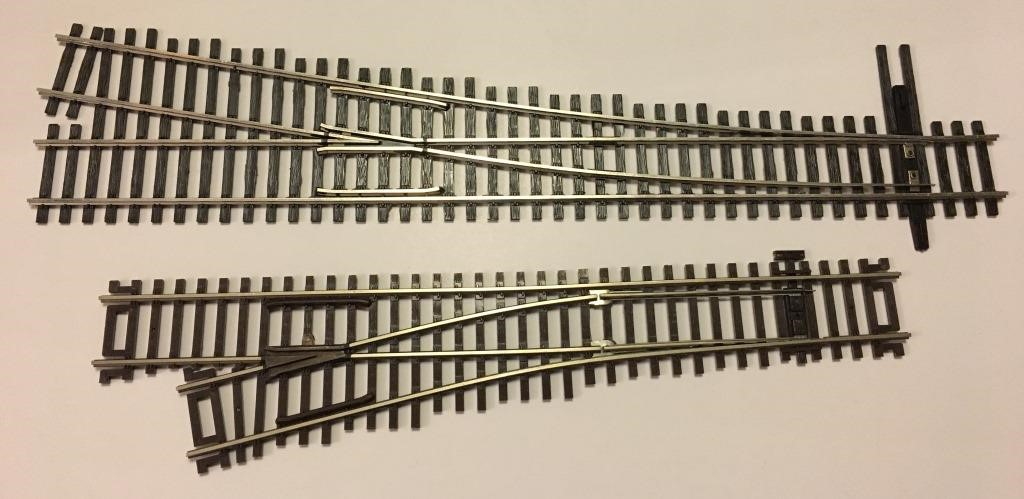 Walthers #6 (top) and Atlas Custom Line #4 (bottom) turnouts
Walthers #6 (top) and Atlas Custom Line #4 (bottom) turnouts Close-up of Atlas Custom Line #4 turnout, showing how the diverging route is straight except between the frog and the points (image coming soon!)
Close-up of Atlas Custom Line #4 turnout, showing how the diverging route is straight except between the frog and the points (image coming soon!)
S-curves – the bane of model railroaders
S-curves, where a curve in one direction leads directly into a curve in the other direction, don’t just look unrealistic. With body-mounted couplers, they can also derail your cars. A car on a curve to the left has its coupler hanging out to the right of the track. If it’s coupled to a car that’s already on an adjacent curve to the right, i.e., an s-curve, that car’s coupler is offset to the left. In many cases, the couplers can’t reach that far, so the lighter car gets pulled off the track.
Tips to avoid s-curves:
-
Have a length of straight track between opposing curves. This straight track should be at least 1.5 times (1 1/2) the length of your longest car. A straight length twice as long as your longest car is preferable.
-
Use easements (see “Flex Track” above).
-
Use turnouts with numbered frogs, where the diverging route is straight through and beyond the frog.
-
Be vigilant around “hidden” s-curves:
In these cases, choose a higher frog number than you would elsewhere on the layout.
What’s this “Code” thing?
If you’ve heard a few model railroaders in conversation, you may think that we have a secret code for talking about track.
Yes, we have a code, but it’s no secret: “Code” refers to the height of the rail in thousandths of an inch. I.e., code 100 is 100 thousandths of an inch high, or one-tenth of an inch: 0.100”. Code 55 is 0.055” high, code 148 is 0.148” high, etc. Note that this refers only to the height of the metal rail, not the total height of the ties and rail.
What code rail should you use? You can build a decent layout using the code common in train sets in your scale (Code 100 for HO or code 80 for N), especially if you use sectional track. But this rail is far oversized for even the busiest, heaviest mainline tracks on the prototype.
Lately, lots of track components have become available in rail sizes that are more realistic-looking, yet still easy to work with and reliable: Codes 148 and 125 in O-scale, code 83 in HO, and code 55 in N. Even smaller rail is available but with fewer ready-made components. Depending on your skill level, you might want to avoid the smaller rail sizes.
Rail joiners
Metal rail joiners, for mechanical and electrical connection between sections of track, are available where you buy the track itself. Be sure to choose a rail joiner compatible with the code of rail you’re using.
Plastic, insulated rail joiners are available too. Why would you want to use insulated rail joiners?
-
To avoid a short-circuit when using turnouts with all-metal frogs that aren’t internally insulated from the rest of the turnout. E.g., Peco and older Shinohara turnouts.
-
To avoid a short-circuit at a wye or reversing loop.
-
To divide a layout with DC (Direct Current) control into multiple blocks, for independent control of two or more trains.
-
To divide a large layout with DCC (Digital Command Control) into “power districts”, so that a short circuit in one area won’t shut down operation in other areas of the layout.
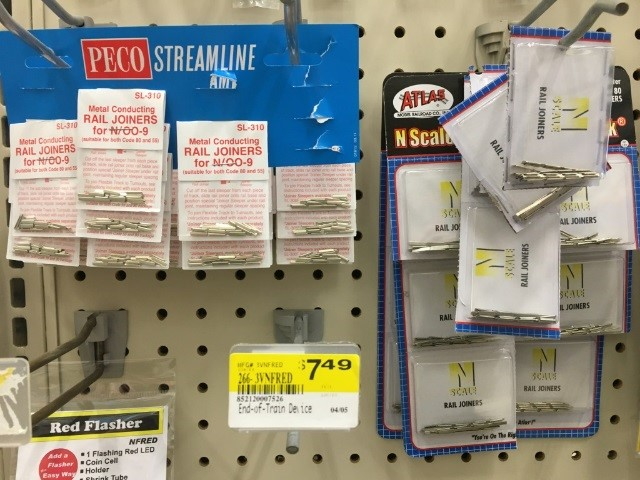 Rail joiners: metal
Rail joiners: metal
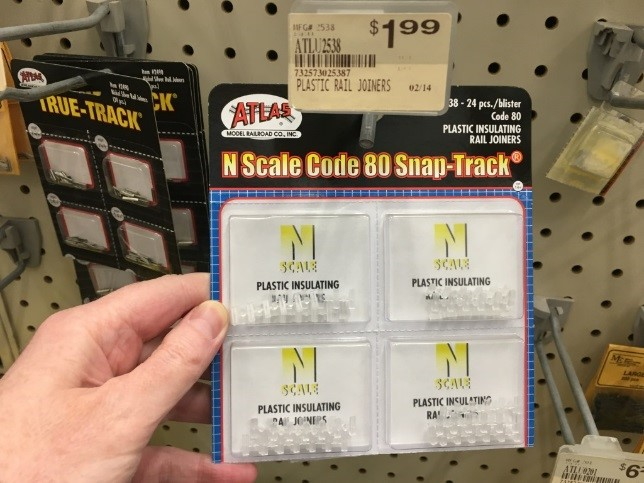 Rail joiners: plastic
Rail joiners: plastic
To repeat what was mentioned before: Use new rail joiners, ensure both rails slide into – not above – each rail joiner, and make sure the joiners grip the rails with a nice, snug fit.
Roadbed
Model railroaders generally lay track on a soft material called “roadbed”, rather than directly on the plywood (which we call “sub-roadbed”).
-
Trains become very noisy when the track is laid directly on plywood.
-
Roadbed, especially types with beveled edges, elevates track around the surrounding countryside to look just like a well-built mainline on a prototype railroad.
There are three main materials used for roadbed, and endless arguments about which is best: Cork, foam, and a pressed-paper board called Homasote.
Cork
Cork roadbed comes in strips just a bit wider than the track. These strips have a rectangular cross-section but are cut almost all the way through at a 45° angle, down the center of the strip. Peel the two halves of the strip apart, and fasten one half down with its back against the track centerline that you’ve marked on the plywood sub-roadbed. Then, lay the other half back-to-back with the first half. Be sure to stagger the joints in the two halves.
You may hear about people soaking cork roadbed, to make it flexible enough to go around curves. This isn’t necessary for new, soft cork. When it’s several years old, it may dry out and become more brittle. In that case, soak it for a while in a tub (with weights to hold it down under the water), then lay it out on a waterproof surface to dry. It should then be as soft and flexible as when it was new.
At joints, it’s always better to leave a little gap than to squeeze too much cork into too small an area. This applies also to turnouts and crossings, where you will have to trim cork strips to fit.
After the cork is secured in place, lightly sand it to provide a smooth, flat surface on which to lay your track. Sand the top edge of the beveled edge of the roadbed, too, to eliminate the “flash” where the two strips were pulled apart: This will make it easier to apply ballast later (after you’ve wired and painted your track). After sanding, if your model railroad is located in a humid environment, it is wise to give it two coats of latex paint before laying the track down. Pick a color paint similar to the ballast you will use. Cork is porous and will absorb moisture. This causes expansion that can distort the trackwork attached to the roadbed.
For yards, stations, industrial areas, and other locations where track sits flat on the ground, rather than on a raised roadbed, use a cork sheet that has the same thickness as the cork strips you use for the mainline.
Foam
Foam is a recent addition to the model railroader’s repertoire of roadbed materials. Some modelers use products aimed at the home improvement market, such as garage door weather stripping. Other products, such as the Woodland Scenics roadbed pictured below, are specifically aimed at us model railroaders.
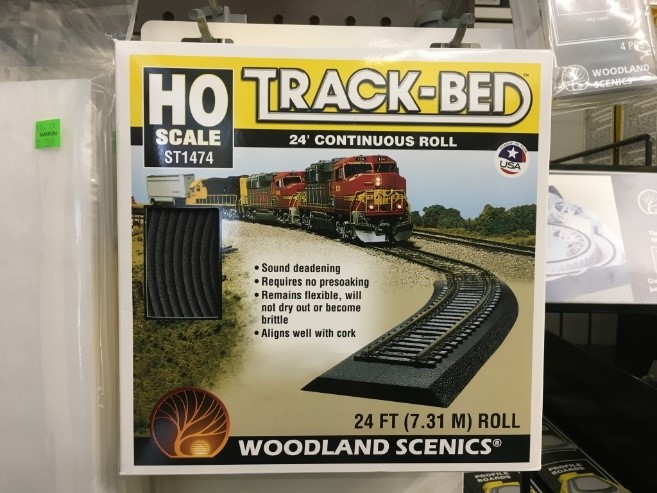 Woodland Scenics’ “Track-Bed” foam roadbed
Woodland Scenics’ “Track-Bed” foam roadbed
Homasote
Homasote is a pressed-paper board, available in 4’ x 8’ or 2’ x 4’ sheets, ½” thick, at home improvement stores. It has excellent sound deadening properties, and holds track spikes and track nails very well. (See “Fastening Track Down”, below.)
Coming in sheets as it does, Homasote needs some work to use it as roadbed, especially in the thin strips a few inches wide needed for mainline track. You can use a jigsaw to cut out the specific curved or straight sections to match your track plan. Alternatively, you can rip a sheet into long, straight strips, then make transverse cuts partway across the strip, alternating between sides, to make the strip flexible so that it will bend around curves. If you’re really ambitious, you can set the saw blade at an angle to get beveled edges on your roadbed. Just be prepared to clean up a lot of dust when cutting Homasote!
Ready-made Homasote roadbed is available from Central & Western HomaRoad Supply.
Be sure to seal Homasote with paint before using any water-based adhesives or scenery materials, to prevent it from swelling.
Fastening Track Down
Prototype railroad track is held down just by its own weight, plus the weight of the gravel “ballast” that is spread around the ties to anchor it in place. Unfortunately, in the small scales, we work with in model railroading, gravity needs some help.
There are two main ways to hold our model track down: Track nails and adhesives.
Track Nails
Many brands of commercial track include holes in the ties for track nails (spikes), i.e. small thin nails available at hobby stores among the track components. In some cases, the holes are partial (to avoid visible holes on the top of the ties) and need to be drilled out from below. In most cases the hole is in the center of the tie; in Walthers and Shinohara turnouts they are right beside the base of the rail. For the latter, an option is miniature track spikes, which are also used for hand-laid track.
Homasote roadbed is excellent at holding track nails (and spikes) securely. You can push them in with pliers, and they will stay put. On the other hand, if you use foam or cork roadbed, the track nails need to be long enough to reach the plywood sub-roadbed. In that case, you’ll need a hammer and a nail set to hammer the track nails into place.
Be sure not to force the track nails in too far: They can distort the ties or even break them. There should always be a small gap below the head of the nail: Test whether you can wiggle the track a tiny amount up and down.
Adhesives
To avoid the unsightliness of nail heads at regular intervals in the middle of the track, you can glue the track down. This can give a much better appearance but can be much harder to change at a later date.
If your sub-roadbed and roadbed structure is entirely made of wood and paper products, e.g. plywood, cork and/or Homasote, a wide variety of adhesives can be used. Carpenter’s glue can be used to glue the cork or Homasote roadbed down to the plywood. To glue the track, make sure to use an adhesive that can bond plastic without harming it. It doesn’t hurt to lightly scuff the bottoms of the ties with medium sandpaper, to give some tooth for the adhesive to grip.
If you use foam insulation boards in your layout structure, you must use a foam-safe adhesive such as Liquid Nails for Projects.
Controlling Turnout (Switch) Points
The points are the blade-like tapered rails in a turnout, which move from side to side to route trains to one track or the other.
Some turnouts, especially sectional-track turnouts with integrated roadbed, or Peco turnouts, have built-in over-center springs to hold the points firmly in one position or the other. You just need to press sideways on the plastic nubs at the “throwbar” to snap the points from one position to the other.
For other turnouts where the points can flop around loose (e.g. Walthers, Atlas Custom Line), you need to add a way to change the points’ position and to hold the points in the selected position. A few solutions:
-
Ground throws, e.g., from Caboose Industries. These plastic mechanisms mount with nails or adhesive to a roadbed “pad” beside the turnout’s throwbar, similar to where a switchstand would be located on a prototype turnout. The ground throw’s actuating arm includes pins to engage a hole in the turnout’s throwbar. You may have to trim the ground throw’s actuating arm and/or the end of the turnout’s throwbar.
Be sure to choose a ground throw with internal springs, to absorb the difference between how far the ground throw’s actuating arm moves and how far the switch points move. With Caboose Industries ground throws, choose a model with “S” in the model number.
Most Caboose Industries ground throws do not route electricity of the appropriate polarity to an all-metal frog if your turnout needs power supplied to the frog. They do market a version with a somewhat unsightly set of electric contacts for this purpose.
All other proposed solutions include built-in electric contacts that you can use to supply power to the frog:
-
Mount an electric slide-switch to the roadbed next to the throwbar, with a steel wire to link the switch to the throwbar. Choose a switch whose motion is just slightly more than the motion of the points. When you slide the switch, the points move.
-
Mount a cable linkage from a control knob on the fascia at the front edge of the layout to a device under the layout such as a “Blue Point” switch machine, or a “BullFrog” from Fast Tracks.
-
Use a slow-motion “stall-motor” electric switch machine under the layout. A widely available brand is the “Tortoise” by Circuitron.
-
In the past, twin-coil solenoid switch machines were popular. These days, they have largely been replaced by the above methods, with good reason: Twin coils were noisy, could over-stress some turnouts, and either placed a large load on the layout power supply (trains would slow down when you activated one) or needed complex capacitor-discharge circuits.
Note that all of these solutions can also be applied to switches with built-in springs, but it is best to remove the spring first. Otherwise, the linkage, motor, etc. will struggle to move the points.
Also, don’t even THINK of using your flush-cutters (i.e., rail cutters) to cut the steel wire mentioned above. Instead, use sturdy cutters designed to cut hard metal such as steel.
Conclusion
It is very important to have good, smooth, solid, reliable (and good-looking!) track. With the information above and a bit of practice, you can choose and install track that will give you years of reliable and fun operation of your trains.
Video and On-Line Resources
Credits
Many thanks to the members (particularly Bruce Wolf) of Division 6 of the North Central Region, NMRA for permission to use their content in this part of the Guide.






